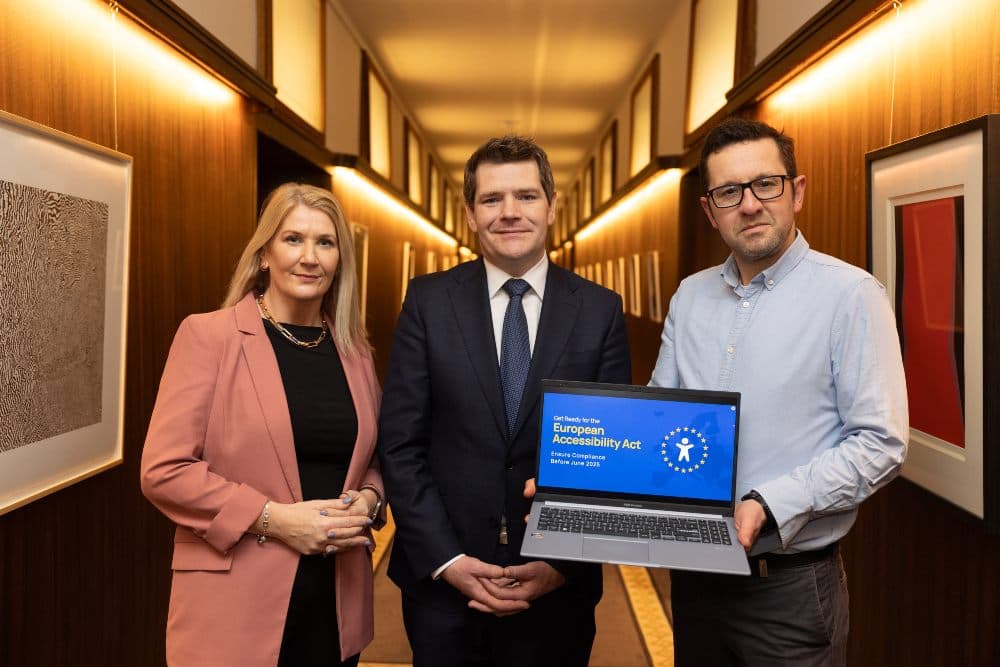Barry Walsh looks at how the new European Accessibility Act will impact SME businesses and gathers top tips for making digital products more accessible.
June 28th saw the implementation of The European Accessibility Act. This groundbreaking act is an EU directive that unites accessibility requirements for a wide range of products and services – such as computers, smartphones, ATMs, e-books, banking, and e-commerce; ensuring they are accessible to people with disabilities across all EU member states.
The EAA aims to remove barriers created by inconsistent national rules, making it easier for businesses to trade across the EU while improving access for millions of consumers. The Act requires companies selling covered products and services in the EU to meet specific accessibility standards, supporting equal participation in the digital economy and everyday life
“For Irish SMEs, the message from leading experts is clear: compliance is not just a legal obligation but an opportunity to reach more customers and future-proof your business”
I asked two of Ireland’s premier digital accessibility specialist companies to give their top tips for SMEs to comply with the act and make their digital products more accessible so that more consumers can access them.
Accessibility Ireland
Accessibility Ireland is dedicated to ensuring that everyone has equal access to digital information, products, and services. Driven by a clear mission to bridge the significant gap in education and awareness around digital accessibility in Ireland, the organisation empowers companies to create inclusive digital experiences, from websites and apps to digital documents.
Through community events, partnerships, and tailored training, Accessibility Ireland champions the belief that digital accessibility is not just a technical requirement but a vital step towards a more equitable society for all.
Below are its top 5 tips:
- Invest wisely
Many companies new to accessibility seek quick fixes, often turning to overlays or paid automated tools. However, overlays do not make a website accessible or compliant with European accessibility legislation—as explicitly stated by the European Disability Forum.
Automated tools, while useful, typically detect only about 30% of accessibility issues. Many vendors overpromise their capabilities but, in reality, free tools like WAVE, IBM Equal Access checker, Axe and Google Lighthouse can uncover most of the same issues as paid solutions.
Instead, prioritise investing in accessibility experts and training. Build a long-term strategy that integrates accessibility into your development process from the start.
- Take small steps
If your team is new to accessibility, don’t expect instant expertise or 100% compliance. That’s unrealistic and can lead to frustration or burnout.
Start small. Taking incremental steps helps avoid overwhelming your team, supports steady progress, and lays the foundation for long-term success. Focus first on role-specific training and critical accessibility issues that directly block users from accessing or interacting with your app or website.
Immerse yourself in accessibility communities and groups and come along to meetups and events to learn more about accessibility and engage with advocates and experts.
- Do your research
If you’re considering hiring an agency to support your accessibility efforts, do your homework. Ask first:
- Do they have a dedicated accessibility professional or team?
- How long have they been working in accessibility?
- Can they share their accessibility standards or checklists?
You can even run a quick automated test on their own website using a free tool. If they don’t meet basic standards themselves, that’s a red flag.
- Embed accessibility throughout your product
Fixing accessibility issues only during QA is inefficient and costly. It creates a cycle of rework that delays releases and increases expenses.
Accessibility is much less costly, time-consuming and simpler if it’s embedded at the very beginning, during the initial concept phase (ideation and design). It also results in a much more inclusive and higher-quality product overall.
- Lead by example
Meaningful accessibility improvements start at the top. When leadership actively supports and prioritises accessibility, it signals that inclusion is a core company value and not just a compliance task.
Visible actions make a big impact. Including accessibility in team goals, celebrating accessibility milestones and setting aside time for learning all help build a culture of accountability and long-term commitment.
Devally
Devally is an Irish-founded technology startup specialising in digital accessibility solutions. Established by Cormac Chisholm, Patrick Guiney-Fox, and Darren Britton, Devally has developed an AI-powered, self-serve platform that enables businesses to audit and fix website and app accessibility issues rapidly, ensuring compliance with regulations like the European Accessibility Act.
The company’s innovation earned it a top-three spot at Slush 2024, a leading global startup competition. Devally’s mission is to make digital products inclusive for all users, regardless of ability, by integrating advanced automation and expert guidance directly into the development process.
Here are its tips:
- Determine the scope your products and services are affected by the European Accessibility act. Your business may be considered a Microenterprise (businesses with limited resources), and are as such exempt from certain accessibility requirements, particularly if they provide services. This exemption is important as the compliance burden for microenterprises is typically higher, relative to their financial and human resources.
- Seek Support from the National Disability Authority, who are providing guidance to help SMEs comply with the EAA. This includes tools and resources to facilitate implementation, developed in consultation with key stakeholders.
- Take a more proactive approach to accessibility through Universal Design which makes products, services, and environments usable by all people without the need for specialized design. This approach includes offering content in multiple formats (text, images, audio), enabling users to customize their experience (e.g., text size, contrast), and ensuring simplicity for users with limited cognitive abilities.
- Where possible, engage with people with disabilities to test and inform your products and services and ensure that they are usable.
For Irish SMEs, the message from leading experts is clear: compliance is not just a legal obligation but an opportunity to reach more customers and future-proof your business.
Rather than relying on quick fixes or automated tools alone, businesses should invest in expert guidance, embed accessibility from the earliest stages of development, and take incremental, manageable steps to build lasting accessibility practices.
Main image: Photo by Amélie Mourichon on Unsplash
-
Bank of Ireland is welcoming new customers every day – funding investments, working capital and expansions across multiple sectors. To learn more, click here
-
For support in challenging times, click here
-
Listen to the ThinkBusiness Podcast for business insights and inspiration. All episodes are here. You can also listen to the Podcast on:
-
Spotify
-
SoundCloud
-
Apple






